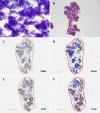Utility of Proliferation Markers Ki-67 and PHH3 in Predicting Malignancy in Basaloid Salivary Gland Neoplasms: A Study Using Digital Image Analysis of Cytology Cell Blocks
- PMID: 40007129
- PMCID: PMC11959683
- DOI: 10.1002/dc.25453
Utility of Proliferation Markers Ki-67 and PHH3 in Predicting Malignancy in Basaloid Salivary Gland Neoplasms: A Study Using Digital Image Analysis of Cytology Cell Blocks
Abstract
Introduction: Basaloid salivary gland neoplasms (BSNs) are notoriously difficult to classify in fine needle aspiration (FNA) specimens due to the morphologic overlap of benign and malignant entities. Adenoid cystic carcinoma (AdCC) represents a particular diagnostic challenge, as it typically shows low-grade cytologic features despite its aggressive clinical behavior. We examined whether the proliferation markers Ki-67 and PHH3 could help predict malignancy in BSNs.
Methods: A retrospective search was conducted to identify FNA cases of BSNs that had adequate tumor cellularity in the cell block and a subsequent excision specimen. Ki-67 and PHH3 immunohistochemical stains were performed. Aperio (Leica Biosystems) was used to calculate the percentage of tumor cell nuclear expression. Proliferation scores and final histopathologic diagnoses were correlated using a two-sided p-value test.
Results: Ten benign and 14 malignant basaloid neoplasms were analyzed. Benign cases showed low mean percentages of tumor cell staining for Ki-67 (1.14%) and PHH3 (0.84%), while malignant cases showed significantly higher mean percentages, especially with Ki-67 (19% for low-grade malignancies and 25.5% for high-grade malignancies). The difference in proliferation marker scores between the benign and low-grade malignant cases showed statistical significance for both Ki-67 (p = 0.0041) and PHH3 (p = 0.00397). The difference between benign entities and AdCC was also statistically significant for Ki-67 (p = 0.0013) and PHH3 (p = 0.002).
Conclusion: Ki-67 and PHH3 analysis in cell block material may help predict malignancy in a cytologic specimen from a BSN, offering a valuable ancillary tool for cases with cytomorphologic ambiguity. In particular, the ability to suggest a sample is more likely to be AdCC rather than another morphologically similar low-grade BSN would be helpful for surgical planning.
Keywords: basaloid; cytopathology; digital image analysis; fine‐needle aspiration; immunohistochemistry; proliferation markers; salivary gland neoplasms.
© 2025 The Author(s). Diagnostic Cytopathology published by Wiley Periodicals LLC.
Conflict of interest statement
The authors declare no conflicts of interest.
Figures






Similar articles
-
Cytohistologic correlation of basaloid salivary gland neoplasms: Can cytomorphologic classification be used to diagnose and grade these tumors?Cancer Cytopathol. 2020 Feb;128(2):92-99. doi: 10.1002/cncy.22208. Epub 2019 Nov 19. Cancer Cytopathol. 2020. PMID: 31742931
-
Improving fine needle aspiration to predict the tumor biological aggressiveness in pancreatic neuroendocrine tumors using Ki-67 proliferation index, phosphorylated histone H3 (PHH3), and BCL-2.Ann Diagn Pathol. 2023 Aug;65:152149. doi: 10.1016/j.anndiagpath.2023.152149. Epub 2023 Apr 21. Ann Diagn Pathol. 2023. PMID: 37119647
-
The Utility of MYB Immunohistochemistry (IHC) in Fine Needle Aspiration (FNA) Diagnosis of Adenoid Cystic Carcinoma (AdCC).Head Neck Pathol. 2021 Jun;15(2):389-394. doi: 10.1007/s12105-020-01202-7. Epub 2020 Jul 13. Head Neck Pathol. 2021. PMID: 32661670 Free PMC article.
-
Fine-Needle Aspiration Cytology of Cellular Basaloid Neoplasms of the Salivary Gland.Arch Pathol Lab Med. 2019 Nov;143(11):1338-1345. doi: 10.5858/arpa.2019-0327-RA. Epub 2019 Sep 11. Arch Pathol Lab Med. 2019. PMID: 31509452 Review.
-
Pitfalls in Salivary Gland Cytology.Acta Cytol. 2024;68(3):194-205. doi: 10.1159/000538069. Epub 2024 Feb 28. Acta Cytol. 2024. PMID: 38417405 Review.
References
-
- Faquin W. C., Rossi E. D., Baloch Z., et al., eds., The Milan System for Reporting Salivary Gland Cytopathology, 2nd ed. (Springer International Publishing, 2023).
MeSH terms
Substances
LinkOut - more resources
Full Text Sources
Medical

